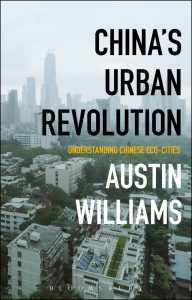Reflecting on Britain’s New Towns
‘Britain’s New Towns: Garden Cities to Sustainable Communities’ by Anthony Alexander; Taylor & Francis, 2009. 199pp
Reviewed by Alastair Donald | 21 October 2009
When Ebenezer Howard, clerk, utopian thinker, inventor and spiritualist, attended a séance in 1926, he received this message from his first wife: “You have accomplished more than you know”. It’s unclear what the former Mrs Howard thinks of the New Town descendents of Howard’s Garden Cities. However, when architects and planners talk of ‘fallen utopias’, it’s not difficult to detect their disappointment. This ‘narrative’ of the New Towns programme aims to ‘learn the lessons’.
Using a wide range of sources, some familiar, the book nicely brings out the myriad of tensions that characterised the new towns programme. Post-war optimism – exemplified by bright cartoonish public service films like Charley in New Town and the pioneering spirit of the new towners – co-existed with continued rationing, and a paternalistic state driving through extensive new controls over development.
All are writ large in the architectural and urban design experiments of the day. Alexander captures the fusion garden city and modern movement ideals – the reaction to industrialisation and the embrace of technology, of artisan ideals and industrial processes, of suburban neighbourhoods and megastructures. Abercrombie, the patrician central figure, straddles the traditionalist CPRE reaction to the democratisation of the countryside, and a modernist emphasis on urbanity. The modernising and modernist sensibilities evident in some civic architecture including hospitals and schools jarred with poor quality housing and materials, and the quality of public services. Even as newspapers highlighted bold experiments and dream towns, William Beveridge warned the first occupants of Newton Aycliffe his offer was a life with “no gardens, few roads, no shops and surrounded by a sea of mud”.
Yet the new towners refused to be trapped in the mud. A spirited independence and the opportunities of automobility increasingly undermined planners’ desire for self containment of neighbourhood and town. Here we glimpse where the new towns experiments really fell short. Even in Milton Keynes, which embraced metropolitan scale exchange and experimented with urban designs that reflected the transport patterns of the age, the experiments didn’t go far enough. Recently, as official hostility to mobility mounts, planners disdain ‘mechanical’ experiments for ‘biological’ evolution, ironically, the very factor which failed to accommodate technological innovations in the first place.
Ultimately, the central tension in the text reflects Alexander’s belief that ‘sustainable communities’ inherit the new towns tradition. Yet the management speak targets that fuel the Sustainable Communities programme, “diverse…. inclusive, well planned, built and run”, compare poorly with the ambition expressed by Lord Reith, Chair of the New Towns Committee, of conducting “an essay in civilisation”, and later by Frederick Gibberd: “Citizenship, civil, civic, civilised, civilisation”. Civic ambition is something more than is evident in the instrumental aims of today’s community architects. The humanising aspirations which motivated Gibberd to filter the landscape through Harlow are a world away from the sustainable demands for green infrastructure – effectively to protect nature from human communities.
The new town experiments might not always have worked, or been taken far enough. But some of the ambition that the book captures, and which motivated valuable experiments with new urban arrangements and architectural forms, seem worth recovering.
This review was first published in Blueprint






